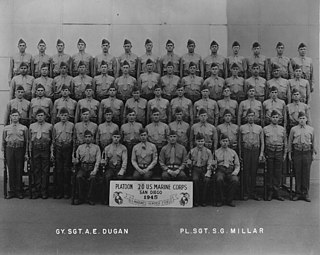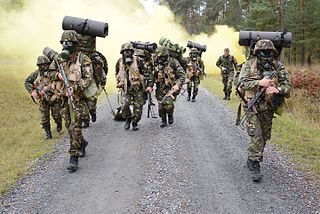
In military organizations, a colour guard is a detachment of soldiers assigned to the protection of regimental colours and the national flag. This duty is highly prestigious, and the military colour is generally carried by a young officer (ensign), while experienced non-commissioned officers are assigned to the protection of the national flag. These non-commissioned officers, accompanied in several countries by warrant officers, can be ceremonially armed with either sabres or rifles to protect the colour. Colour guards are generally dismounted, but there are also mounted colour guard formations as well.
A company is a military unit, typically consisting of 100–250 soldiers and usually commanded by a major or a captain. Most companies are formed of three to seven platoons, although the exact number may vary by country, unit type, and structure.

Military ranks are a system of hierarchical relationships, within armed forces, police, intelligence agencies or other institutions organized along military lines. The military rank system defines dominance, authority, and responsibility in a military hierarchy. It incorporates the principles of exercising power and authority into the military chain of command—the succession of commanders superior to subordinates through which command is exercised. The military chain of command constructs an important component for organized collective action.

A platoon is a military unit typically composed of two to four squads, sections, or patrols. Platoon organization varies depending on the country and the branch, but a platoon can be composed of 20–50 troops, although specific platoons may range from 10 to 100 people. A platoon is typically the smallest military unit led by a commissioned officer. The platoon leader is usually a junior officer—a second or first lieutenant or an equivalent rank. The officer is usually assisted by a platoon sergeant.

In military terminology, a squad is among the smallest of military organizations and is led by a non-commissioned officer. NATO and U.S. doctrine define a squad as an organization "larger than a team, but smaller than a section." while U.S. Army doctrine further defines a squad as a "small military unit typically containing two or more fire teams." In American usage, a squad consists of eight to fourteen soldiers, and may be further subdivided into fireteams.

A fireteam or fire team is a small modern military subordinated element of infantry designed to optimize "NCO initiative", "combined arms", "bounding overwatch" and "fire and movement" tactical doctrine in combat. Depending on mission requirements, a typical "standard" fireteam consists of four or fewer members: an automatic rifleman, a grenadier, a rifleman, and a designated fireteam leader. The role of each fireteam leader is to ensure that the fireteam operates as a cohesive unit. Two or three fireteams are organized into a section or squad in co-ordinated operations, which is led by a squad leader.

A non-commissioned officer (NCO) is a military officer who does not hold a commission. Non-commissioned officers usually earn their position of authority by promotion through the enlisted ranks. In contrast, commissioned officers usually enter directly from a military academy, officer training corps (OTC) or reserve officer training corps (ROTC), or officer candidate school (OCS) or officer training school (OTS), after receiving a post-secondary degree.
Sergeant is a rank in use by the armed forces of many countries. It is also a police rank in some police services. The alternative spelling, serjeant, is used in The Rifles and other units that draw their heritage from the British light infantry. Its origin is the Latin serviens, 'one who serves', through the Old French term serjant.
Corporal is a military rank in use by the armed forces of many countries. It is also a police rank in some police services. The rank is usually the lowest ranking non-commissioned officer. In some militaries, the rank of corporal nominally corresponds to commanding a section or squad of soldiers.
Staff sergeant is a rank of non-commissioned officer used in the armed forces of many countries. It is also a police rank in some police services.
A master sergeant is the military rank for a senior non-commissioned officer in the armed forces of some countries.
Gunnery Sergeant (GySgt) is the seventh enlisted rank in the United States Marine Corps, above staff sergeant and below master sergeant and first sergeant, and is a senior non-commissioned officer (SNCO). It has a pay grade of E-7.
The chart below shows the current enlisted rank insignia of the United States Army, with seniority, and pay grade, increasing from right to left. The enlisted ranks of corporal (E-4) and higher are considered non-commissioned officers (NCOs). The rank of specialist is also in pay grade E-4, but does not hold non-commissioned officer status; it is common that a soldier may never hold the rank of corporal, and instead be promoted from specialist to sergeant, attaining junior NCO status at that time.

A section is a military sub-subunit. It usually consists of between 6 and 20 personnel. NATO and U.S. doctrine define a section as an organization "larger than a squad, but smaller than a platoon." As such, two or more sections usually make up an army platoon or an air force flight.
Company quartermaster sergeant is a military rank or appointment.

The Basic School (TBS) is where all newly commissioned and appointed United States Marine Corps officers are taught the basics of being an "Officer of Marines." The Basic School is located in Stafford County, Virginia to the south-west of the Marine Corps Base Quantico complex. Each year, over 1,700 new officers are trained, representing such commissioning sources as the U.S. Naval Academy, Navy ROTC, Officer Candidates School, and Marine Corps Limited Duty Officer (LDO) and Warrant Officer, U.S. Merchant Marine Academy accession programs.

The United States Marine Corps is organized within the Department of the Navy, which is led by the Secretary of the Navy (SECNAV). The most senior Marine commissioned officer is the Commandant of the Marine Corps, responsible for organizing, recruiting, training, and equipping the Marine Corps so that it is ready for operation under the command of the unified combatant commanders. The Marine Corps is organized into four principal subdivisions: Headquarters Marine Corps, the Operating Forces, the Supporting Establishment, and the Marine Forces Reserve.
In many militaries, a platoon sergeant is the senior enlisted member of a platoon, who advises and supports the platoon's commanding officer in leading the unit.

All branches of the United States Armed Forces use the general term Enlisted Professional Military Education (EPME) to describe the formal system of education which each branch provides to its enlisted personnel. Each branch has its own system and sequence of courses, with the overall focus on leadership and management. Education generally increases in intensity and level of knowledge as individuals progress in rank and assume broader leadership roles. EPME is distinct from the technical training which service members receive for their Military Occupational Specialty (MOS), Air Force Specialty Code (AFSC), or Navy Rating.










